From beautiful color combinations to heirloom cultivars, there are many amazing types of daffodils! With so many varieties, it’s no wonder that the daffodil is one of the most popular and cherished spring flowers. Some daffodils are special for their coloring, while others are coveted for their rich history, hardiness, and unique blooms. Many daffodils have all of those qualities and more.
So let’s explore 9 amazing types of daffodils cherished by gardeners. In some cases, they’ve been favorites for hundreds of years!

The ‘Dutch Master’ heirloom cultivar has the traditional look of an all-yellow trumpet daffodil.
©Dajbog Nicoleta/Shutterstock.com
1. Yellow Daffodils
Are there any daffodils more iconic than the yellow ones? After all, the color yellow represents hope and happiness! It’s hard to beat the classic yellow blooms, no matter your favorite daffodil color and style.
Yellow daffodils make us nostalgic and excited to see these cheerful flowers shining like little golden bells in garden beds, containers, and window boxes.
The Dazzling ‘Dutch Master’ is a Nod to the King
Two of the most loved yellow daffodil cultivars include the heirloom plant ‘King Alfred’ and the hybrid ‘Dutch Master.’ In fact, ‘Dutch Master’ looks so much like the classic ‘King Alfred’ that it seems to pay homage to the king every time it blooms.
‘King Alfred’ isn’t always available from bulb suppliers these days, but waiting lists are available. Scroll down to the rare daffodils section of this post to learn more about this mighty cultivar.
Luckily, ‘Dutch Master’ bulbs are often in stock and a great choice if you love showy golden yellow daffodils with big and frilly trumpet cups.
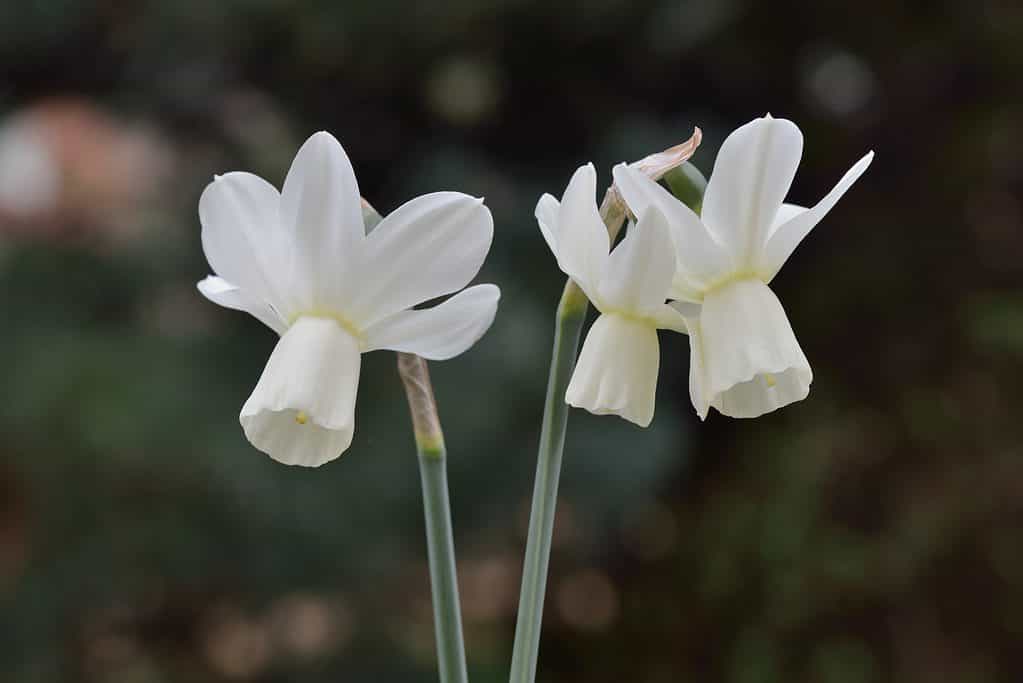
‘Ice Wings’ is a white triandrus daffodil with a sweet fragrance and strongly reflexed petals.
©Walter Erhardt/Shutterstock.com
2. White Daffodils
Graceful white daffodils are perfect flowers for elegant spring blooms. Many white daffodils also come with a touch of yellow in the throat of their cups, but some varieties are as white as snow.
White cultivars are amazing types of daffodils for their non-flashy beauty that symbolizes purity and innocence. They’re also excellent plants to pair with other spring flowers with any color combination.
Icy White ‘Ice Wings’ Daffodil
The triandrus daffodil ‘Ice Wings’ is an all-ivory miniature daffodil with an enticing sweet scent. ‘Ice Wings’ has strongly reflexed petals and graceful nodding blooms.
If multi-colored flowers are more to your taste, you’ll be happy to know that there’s a vast selection of bicolor daffodils available.

The show-stopping yellow and orange ‘Fortissimo’ cultivar is a large-cupped daffodil with 5-inch blooms.
©Andreas Krumwiede/Shutterstock.com
3. Bicolor Daffodils
Some of the most vibrant spring flowers include bicolor daffodils. The most classic-looking bicolor daffodil is yellow and white. However, modern hybrids have color combinations like white with salmon and orange with gold. And these amazing types of daffodils also come from different daffodil divisions, like trumpet, large-cupped, double, and tazetta.
A Favorite ‘Fortissimo’ Bicolor
One bicolor daffodil with a bold and showy style is the ‘Fortissimo’ cultivar. This large-cupped daffodil has yellow petals and red-orange frilly cups. ‘Fortissimo’ also produces impressive 5-inch blooms!
If you love bicolor daffodils but want to try a modern take on the classic colors, find some reverse bicolor daffodil bulbs to plant next fall!

The ‘Pipit’ cultivar is a reverse bicolor hybrid with yellow petals and yellow-to-white cups.
©Andrew Fletcher/Shutterstock.com
4. Reverse Bicolor Daffodils
The reverse bicolor daffodil isn’t new, but it’s certainly one to watch as a type of daffodil that is growing in popularity. Where many bicolor daffodils have white petals with yellow cups, the reverse bicolor hybrids flip those colors around. Their yellow petals often taper into white near the flower cups. And the cups of specific cultivars show off their color-changing magic when they open yellow and soon turn white.
The Popular ‘Pipit’ Daffodil
‘Pipit’ is a popular reverse bicolor hybrid because it’s a charming miniature jonquil with dainty blooms. The flowers are all-yellow when they open, but the cups and inner parts of the petals quickly turn white. The result is a small flower with a big impact and a pleasing fragrance.
Speaking of miniature daffodils, they’re another amazing type of daffodil on our list!
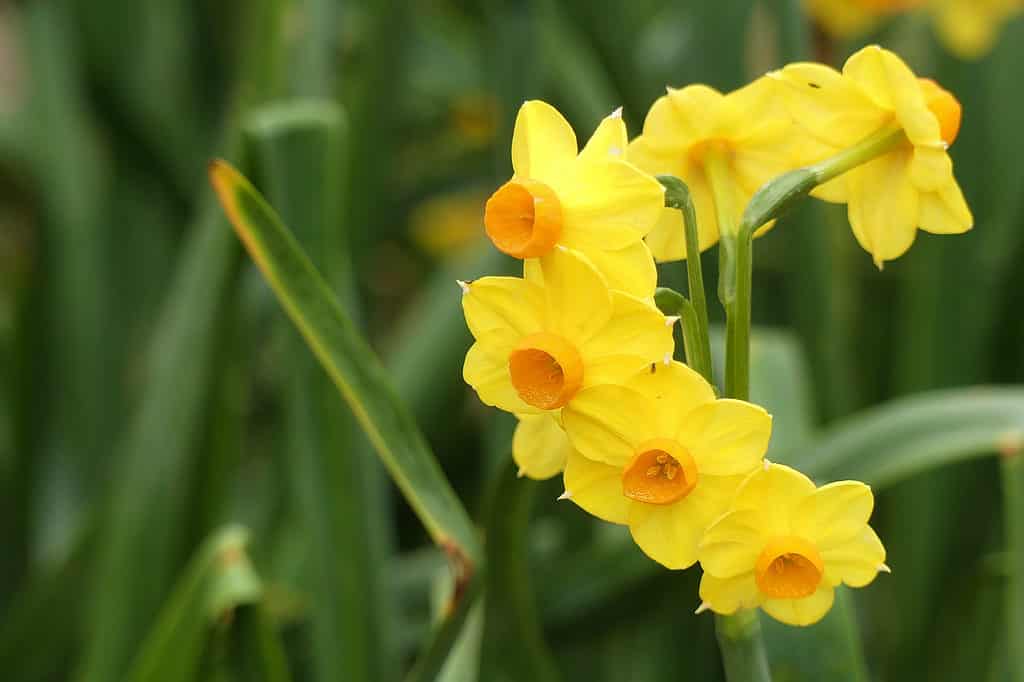
‘Grand Soleil d’Or’ is a miniature tazetta daffodil with bright yellow petals and orange bowl-shaped cups.
©fernandoul/Shutterstock.com
5. Miniature Daffodils
Daffodils come in standard size (12-26 inches) and miniature plants that can vary between 6-14 inches high. Though miniature daffodils are smaller, they’re still hardy and impactful garden flowers. And when you plant these sweet little daffodils in drifts, they always bring a smile when they bloom in the spring.
Miniature daffodils come from different daffodil divisions, like cyclamineus and jonquilla. And most of them bring a noticeably pleasing perfume to yards and garden beds.
The Golden ‘Grand Soleil d’Or’ Cultivar
This miniature daffodil’s French name, ‘Grand Soleil d’Or,’ translates to the golden sun and suits this charming plant. The cute-as-a-button flowers it produces have yellow petals with bowl-shaped orange cups. In addition to its undeniable charm, ‘Grand Soleil d’Or’ features 10-20 sunny, fragrant flowers per stem.
‘Grand Soleil d’Or’ is a popular plant for modern gardens, but records show this daffodil has been around since at least the late 1700s! It’s in great company with the many other heirloom daffodils still available for gardeners around the world today.
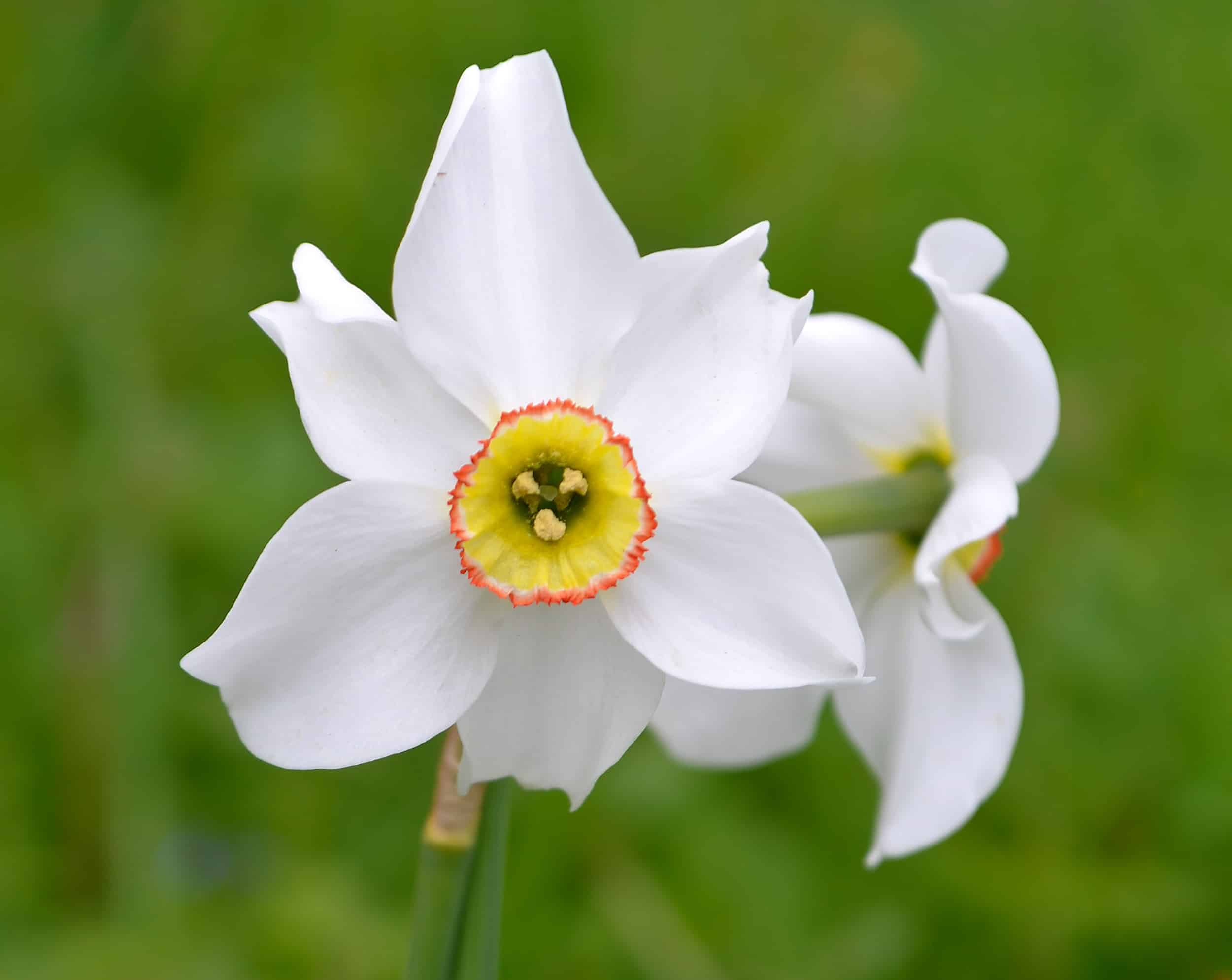
The ‘Pheasant’s Eye’ daffodil is a poeticus daffodil with white petals and yellow cups with reddish rims.
©Emily Goodwin/Shutterstock.com
6. Heirloom Daffodils
Robust and beautiful heirloom daffodils are long-lasting cultivars that have existed for 50 years or more. Some heirloom plants existed centuries ago and are still grown by modern gardeners. The heirloom varieties also have other qualities that make them last, like long bloom seasons and bulbs that multiply quickly. And heirloom daffodils can come from any of the 13 daffodil divisions used to classify them all.
The Famous ‘Pheasant’s Eye’ Flower
Known by its scientific name, Narcissus poeticus var. recurvus, or the Poet’s Narcissus, the ‘Pheasant’s Eye’ daffodil has been featured in literature as far back as the 1600s. And Europeans have been growing it since at least the early 1800s. So though we don’t know the exact age of this plant, the ‘Pheasant’s Eye’ is definitely one of the oldest heirloom daffodils.
‘Pheasant’s Eye’ is also a very fragrant poeticus type of daffodil with white petals and yellow cups rimmed in reddish-orange.
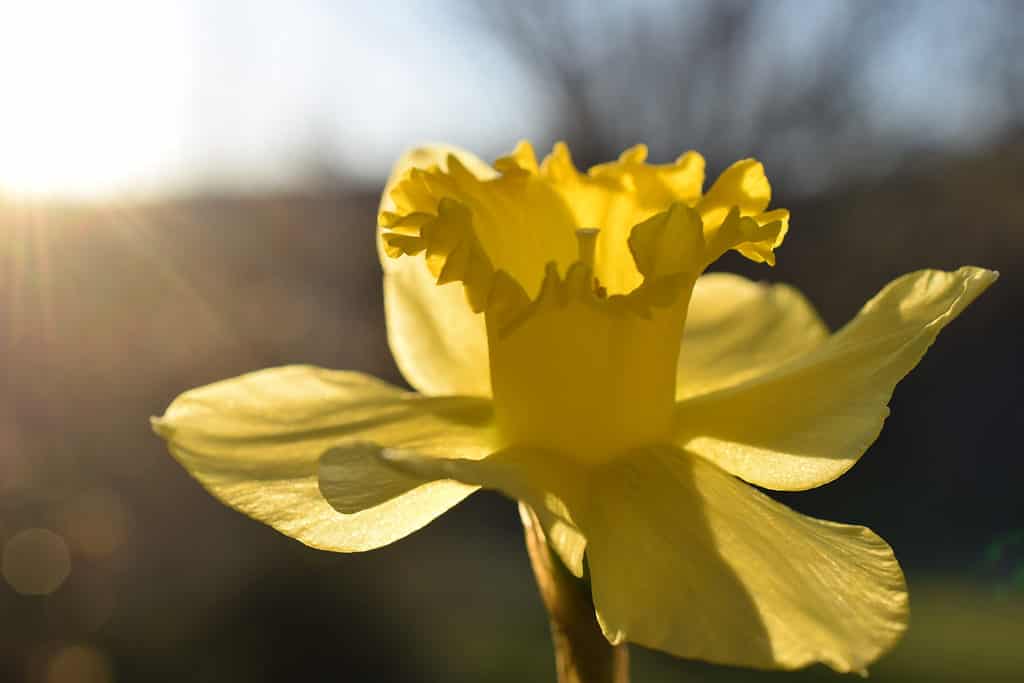
The ‘King Alfred’ heirloom cultivar is a rare all-yellow daffodil from the trumpet division.
©Tracy Burroughs Brown/Shutterstock.com
7. Rare Daffodils
The rarest garden daffodils are often the heirloom varieties that have dropped in popularity due to newer hybrids. However, the rare daffodil marketplace is alive and well via heirloom bulb suppliers. Though many rare cultivars have fallen away, some reappear during peak seasons when bulbs are available.
Make Way for Rare and Royal ‘King Alfred’
As we mentioned in the yellow daffodils section of this post, the ‘King Alfred’ daffodil is a long-respected heirloom cultivar. However, ‘King Alfred’ bulbs are much harder to find now that there are many newer hybrids with similar styles. But diehard heirloom bulb growers still favor this amazing type of daffodil for its hardiness, beauty, and history.
First introduced in the late 1800s, the trumpet daffodil ‘King Alfred’ reigned supreme for many years and is still a favorite daffodil today. Its classic all-yellow flowers with showy trumpet cups still give it a kingly presence among the cultivars it sired and inspired.
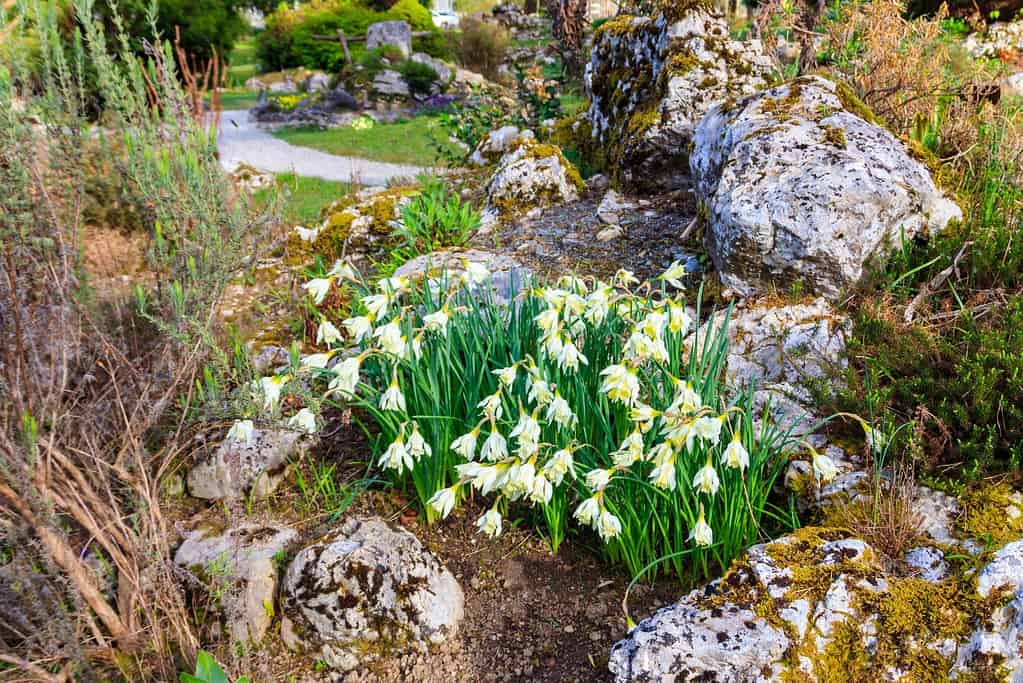
The Lent Lily is a wild daffodil native to
Africa
and Europe that belongs to daffodil division #13.
©Olha Solodenko/Shutterstock.com
8. Wild Daffodils
Trying to pinpoint which daffodils are still or were ever wild plants can get confusing. This confusion is because so many garden daffodils are now growing in non-native environments. But you don’t hear us complaining about that! Fortunately, daffodils are non-native plants in the US that aren’t invasive. In addition, they spread their cheery beauty across disturbed landscapes that might not be as bright and lovely without them.
A large percentage of garden variety daffodils naturalize easily, which is why they can survive in certain wild landscapes for many years.
However, there is one plant still known as a wild daffodil. And it’s a robust, natural beauty!
Wild and Natural Narcissus pseudonarcissus
You may know this wild daffodil as Lent Lily or Lent Rose, but its scientific name is Narcissus pseudonarcissus. Native to Africa and Europe, this wild daffodil is all-yellow with darker golden cups. Additionally, it looks like a trumpet variety but is classified by the Royal Horticultural Society as a division #13 daffodil.
Fortunately, you can grow this wild daffodil in your garden! N. pseudonarcissus bulbs are sometimes available from bulb suppliers.
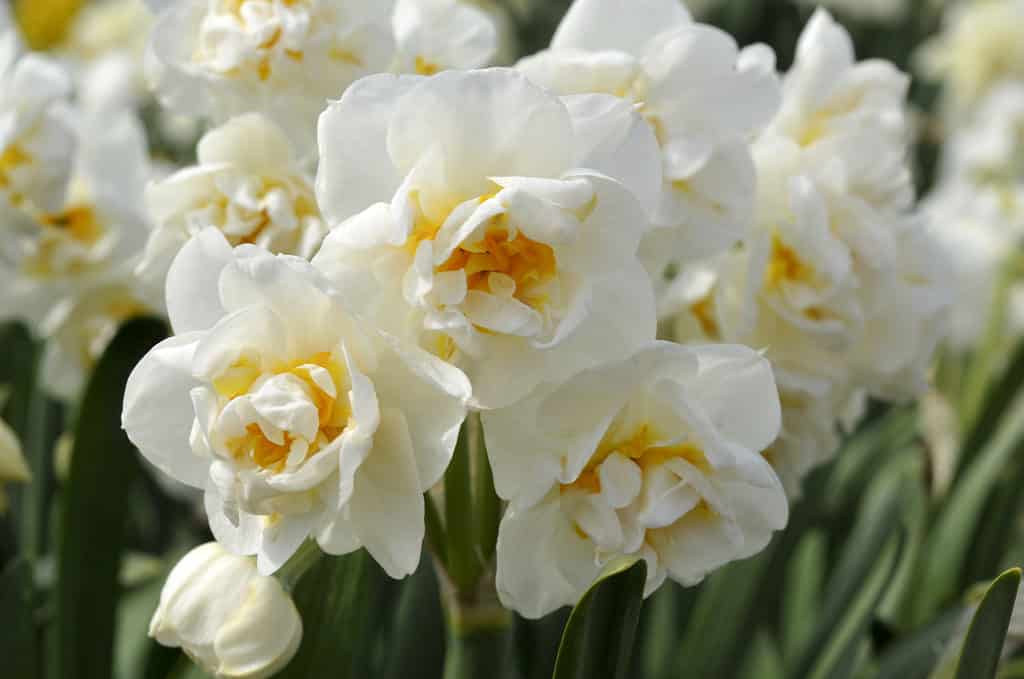
Romantic-looking ‘Bridal Crown’ double daffodils have a sweet fragrance and ultra-fluffy blooms.
©Wiert nieuman/Shutterstock.com
9. Double Daffodils and Other Popular Varieties
Fluffy and romantic-looking double-bloom cultivars are amazing types of daffodils that could be mistaken for roses or peonies. Their elegant blooms have double the petals and cup segments compared to most other types of daffodils. Additionally, these flowers are usually very fragrant. Double daffodils are popular flowers in wedding bouquets and arrangements for these enticing reasons.
The Beautiful ‘Bridal Crown’ Daffodil
‘Bridal Crown’ is a double daffodil with gold center cup segments peeking through its wedding-white petals. This luxurious-looking daffodil also has a sweet scent. And it’s an award-winner, including a recipient of the Award of Garden Merit from the Royal Horticultural Society.
More Popular Daffodils That Deserve the Spotlight
There are many popular types of daffodils, but we couldn’t wrap up this post without giving an extra shout-out for at least the trumpet and jonquil varieties.
- Trumpet daffodils have a traditional style with large, ruffled cups on big, showy blooms. Many are all-yellow and standard size, but they also come in bicolor and miniature varieties. Trumpet daffodils are favored as cut flowers because they grow one large bloom per stem.
- Jonquil (jonquilla) daffodils are highly fragrant beauties, including many miniature cultivars. Plus, they produce anywhere from 1-8 flowers per stem. So one jonquilla plant can provide many gorgeous blooms.
Trumpet and jonquil daffodils are included in the 13 daffodil divisions created by the Royal Horticultural Society. For more information about each, check out our post, The 13 Daffodil Divisions, Explained.

Jonquils like the ‘Sailboat’ cultivar are amazing types of daffodils for their strong scent and many blooms.
©Alex Manders/Shutterstock.com
There are many cherished and amazing types of daffodils!
Newbies to the incredibly layered world of daffodils might be surprised to find that there are so many types, styles, and growth habits. Though the classic yellow trumpet variety is one of them, there are countless amazing types of daffodils! From bicolor cultivars to billowy double blooms, daffodils come in multiple shades, sizes, and scents. And every one of these sweet flowers is cherished for its ability to bring charm and cheer to the earth’s reawakening in spring.
The photo featured at the top of this post is © Photo_Traveller/Shutterstock.com
Thank you for reading! Have some feedback for us? Contact the AZ Animals editorial team.






